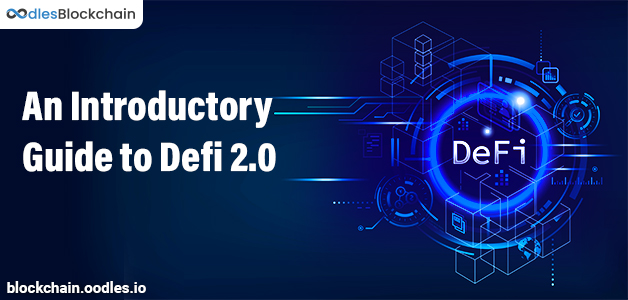-
Decentralized finance, sometimes known as DeFi, has been one of the most significant products or services enabled by blockchain-based fintech development services. Decentralized financial applications (DeFi), which are supported by blockchains with built-in smart contract capabilities, displace traditional financial intermediaries and open up entirely new economic primitives. It has been approximately two years since the emergence of DeFi (Decentralized Finance) in 2020. Since then, trade and finance have become more decentralized, there are new methods to make money in the crypto realm, and we've seen tremendously successful DeFi projects like UniSwap. But in such a new industry, there are still issues to be resolved, just as we saw with Bitcoin (BTC). In response, a new generation of DeFi decentralized applications has gained popularity under the moniker "DeFi 2.0." (DApps) development.
Understanding DeFi 2.0
The DeFi 2.0 movement seeks to fix and advance the shortcomings of the initial DeFi wave. DeFi had faults while being revolutionary in the way it provided decentralized financial services to anyone with a cryptocurrency wallet. This technique has previously been shown to work in the cryptocurrency market by second-generation blockchains like Ethereum (ETH), which outperform Bitcoin. DeFi 2.0 will also need to comply with new compliance regulations like KYC and AML that the government plans to put into place.
Let's examine a case in point. Since DeFi enables liquidity providers to be compensated for staking token pairs, liquidity pools (LPs) have been incredibly profitable. However, liquidity providers run the danger of going bankrupt if the tokens' price ratio changes (impermanent loss). For a nominal cost, a DeFi 2.0 protocol might offer protection from this. Users, stakeholder groups, and the DeFi industry as a whole gain from this solution, which increases the motivation to invest in LPs.
Also, Read | Decrypting Fundamentals of DeFi Aggregator Development
Benefits of DeFi 2.0
DeFi 2.0, the second version of DeFi, makes sure to offer several functions that will make it simple for customers to use the DeFi environment.
Smart contract insurance
You can obtain insurance for smart contracts using DeFi 2.0. As a result, the risks related to smart contracts are diminished. DeFi 2.0 also ensures that consumers are protected from all potential risks of temporary loss.
Self-Repaying Debt
In addition, the second version of DeFi is renowned for lowering the risks connected with loan procedures. It aids in removing the interest that must be paid on loans.
Access to Liquidity
It entails cutting the expense connected with carrying out transactions. As a result, it implies that gas costs are reasonable and that transactions happen quickly. Additionally, DeFi 2.0 assures a reliable source of liquidity.
Also, Read | Yield Farming | Fuelling the Decentralized Finance (DeFI) Space
The best way to invest in DeFi 2.0 Development
The majority of the investment options provided by DeFi 2.0 are identical to those of DeFi but have a larger reach. The following are a few methods for investing in DeFi 2.0:
Yield Farming
You are likely familiar with yield farming if you are familiar with DeFi. For those who don't know, yield farming uses decentralized financing to boost profits. For maximum income, some yield farmers, for instance, constantly switch their cryptos between loan platforms. By enabling the use of yield farm LP tokens as collateral for loans, DeFi 2.0 expands the incentives and usefulness of yield farming.
Lending
Offering loans in exchange for interest is another method to invest in DeFi 2.0. DeFi 2.0 loans give both lenders and borrowers a lot of peace of mind because they are self-repaying.
Liquidity Mining
Cryptocurrency owners can lend their assets to decentralized exchanges for benefits thanks to liquidity mining. These benefits are frequently obtained from the trading fee that participants in token swaps must pay. The cost is per exchange, and the lender's overall payout varies according to how much of the liquidity pool they control.
Staking
On a blockchain network that uses proof-of-stake as its consensus method, staking enables a user to become a validator. Simply secure your cryptocurrency on the blockchain to collect block rewards.
DEX Development
Cryptocurrency transactions are facilitated by decentralized exchanges (DEXs) without the involvement of third parties like banks. These transactions may take place in many states and nations under strict regulation. However, due to its decentralized structure, DEX trading is not governed by these laws. Additionally, DEX trading is more affordable than trading on centralized exchanges and supports a variety of activities, including margin trading.
Also, Read | Cross-chain Defi Development: The New Big Thing for Future
Conclusion
Although there are many effective projects in the DeFi sector right now, DeFi 2.0 has not yet reached its full potential. Nobody should utilize financial products they don't fully understand because the majority of clients still find the topic to be challenging. It is still necessary to provide a simpler method, especially for new users. It has been successful to use new strategies to reduce risk and produce APY, but it is unclear whether DeFi 2.0 will live up to its full potential. Reach out to our skilled defi and crypto development experts for more information about DeFi 2.0.

Our Offices
INDIA
Emaar Digital Greens, Sector 61,
Gurugram, Haryana
122011.
Welldone Tech Park,
Sector 48, Sohna road,
Gurugram, Haryana
122018.














